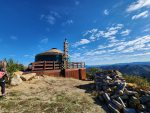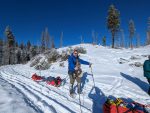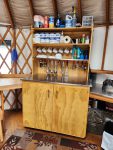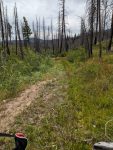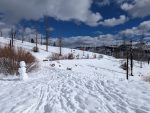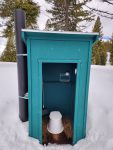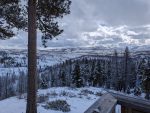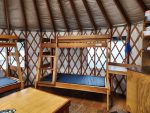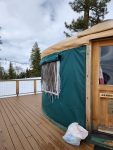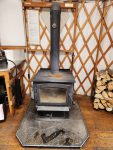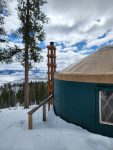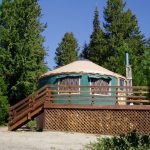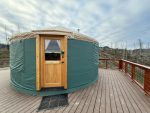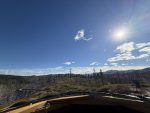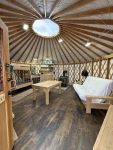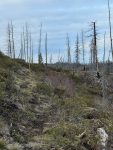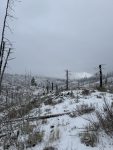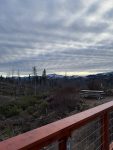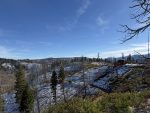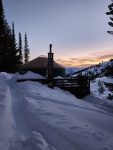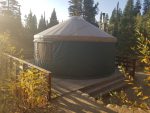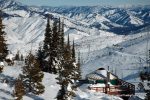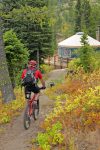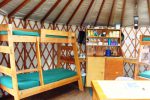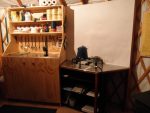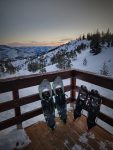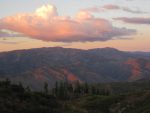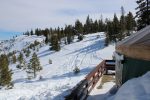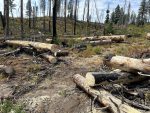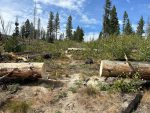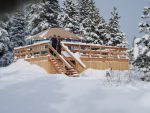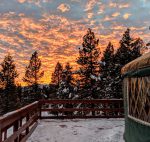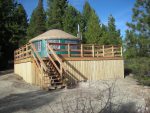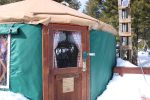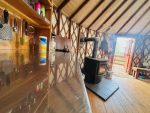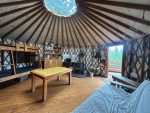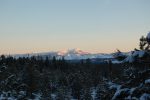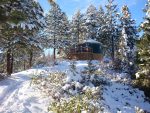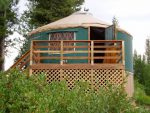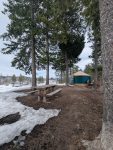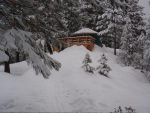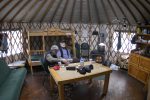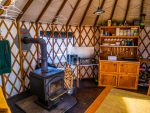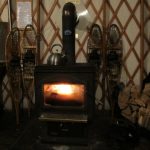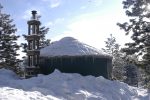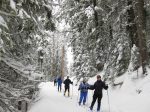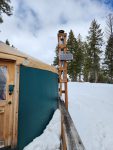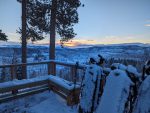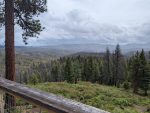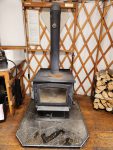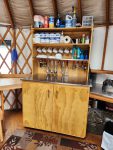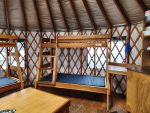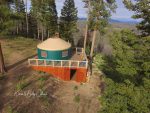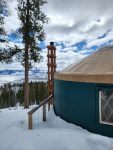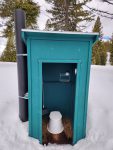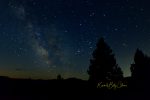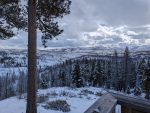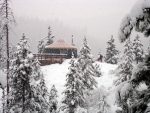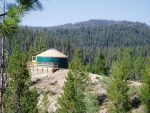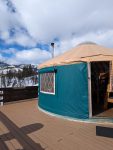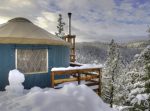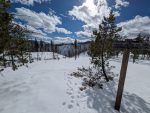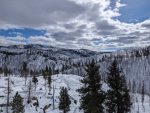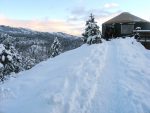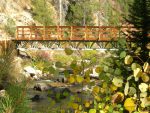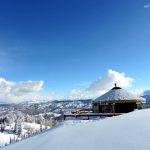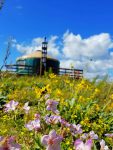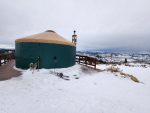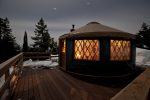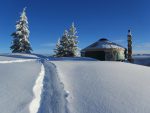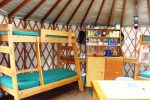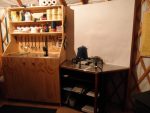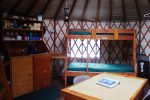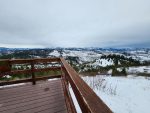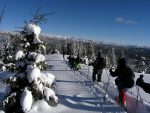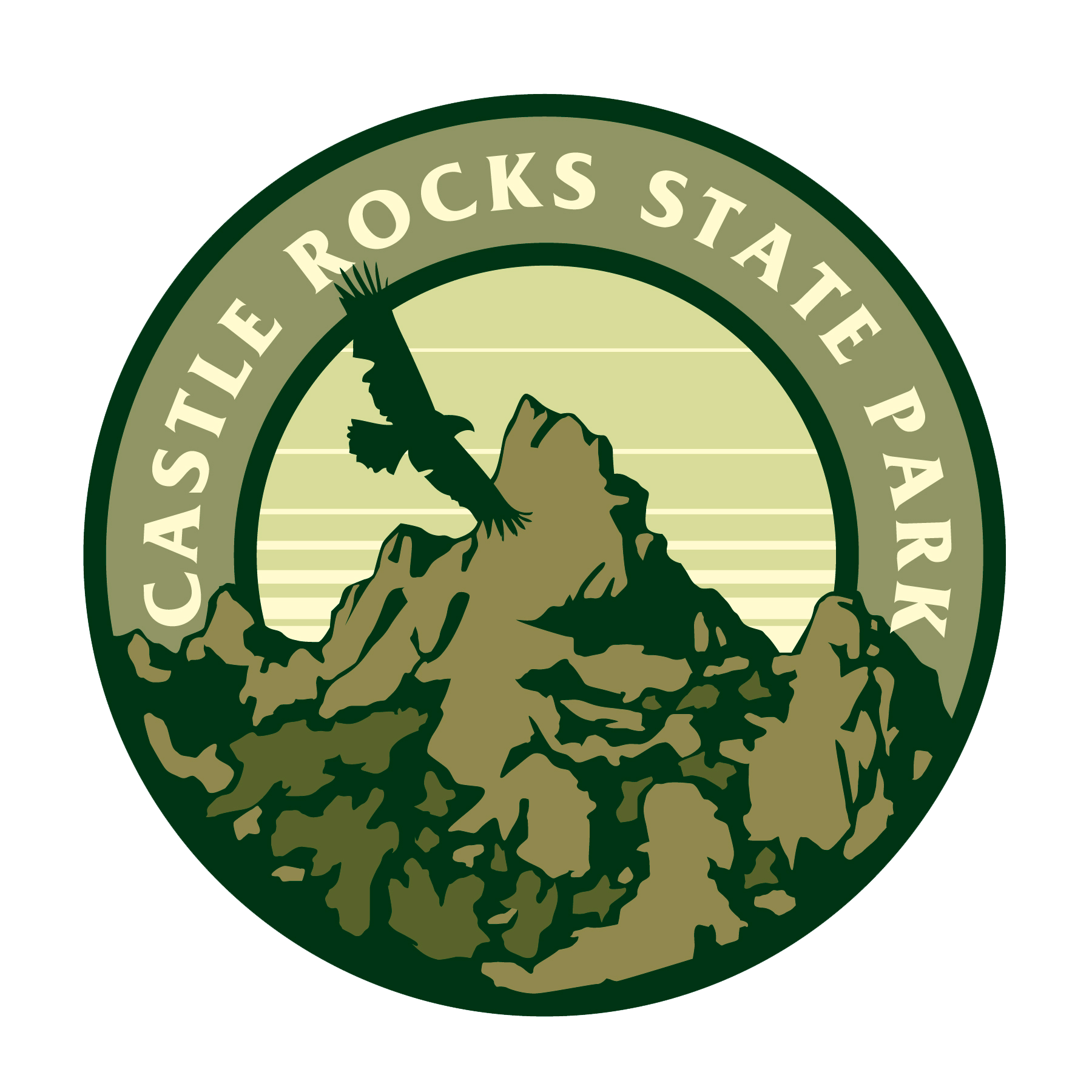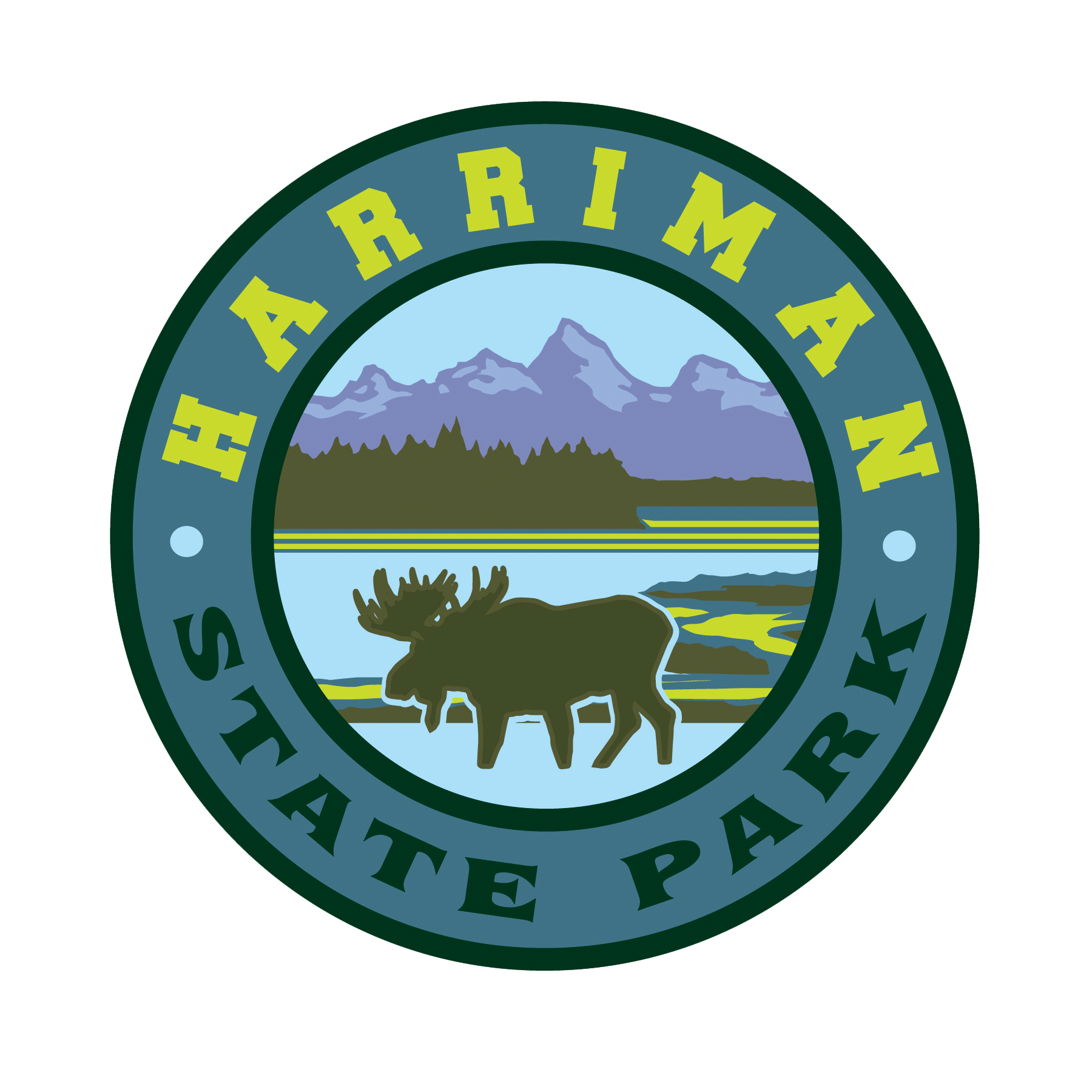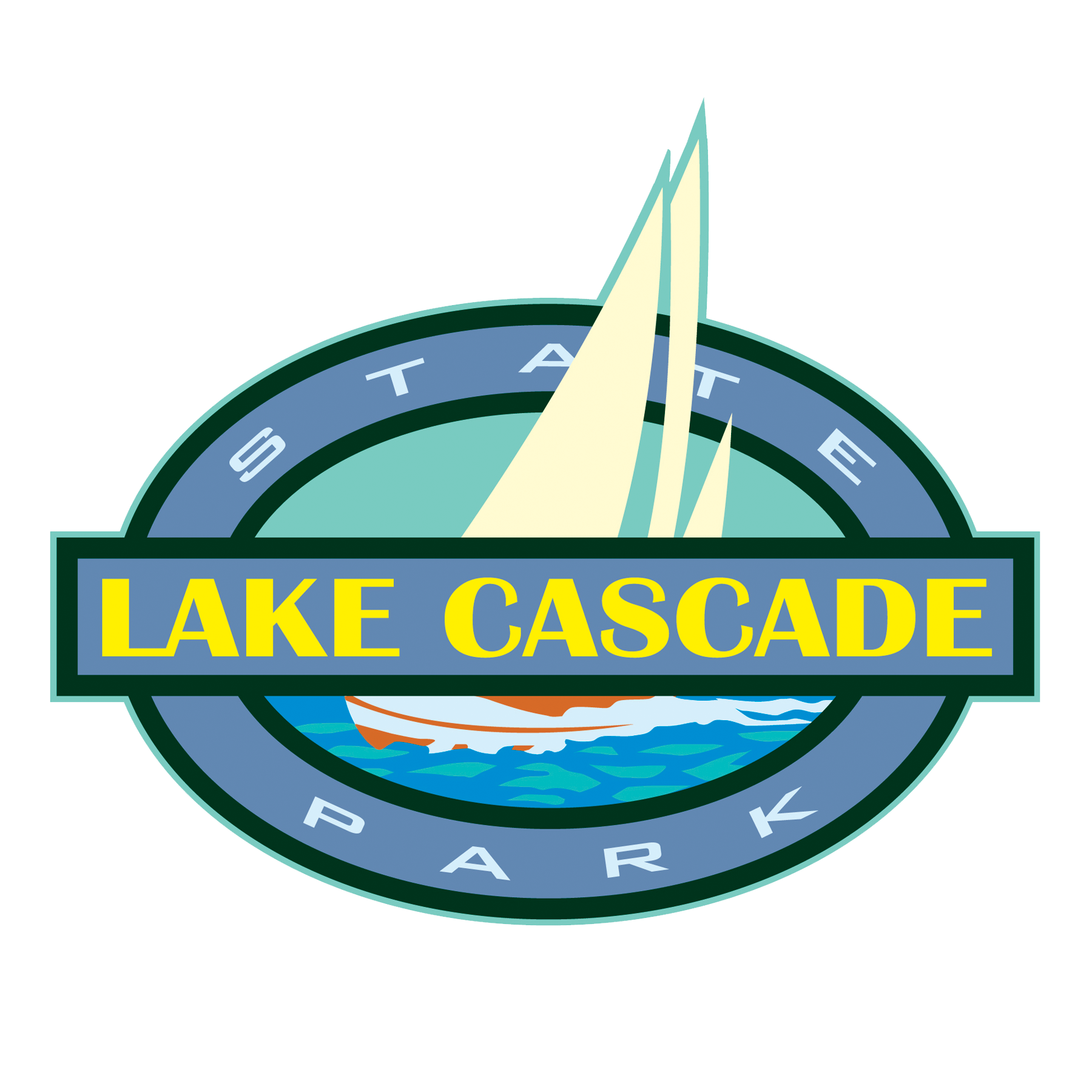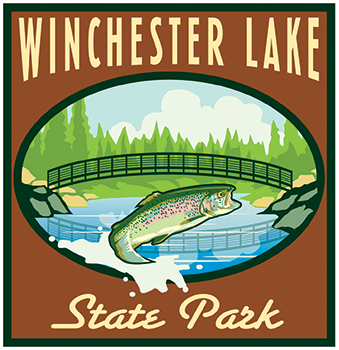 Official Government Website
Official Government WebsiteYurts
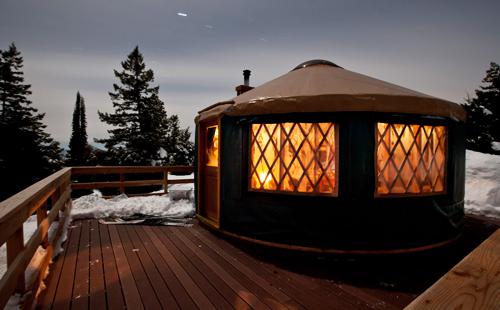
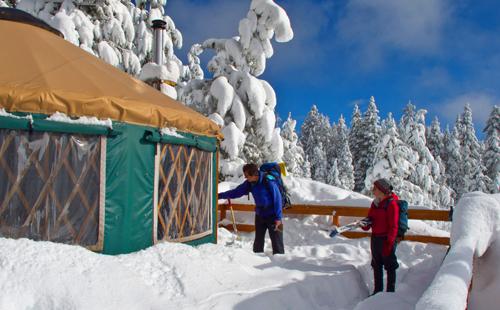
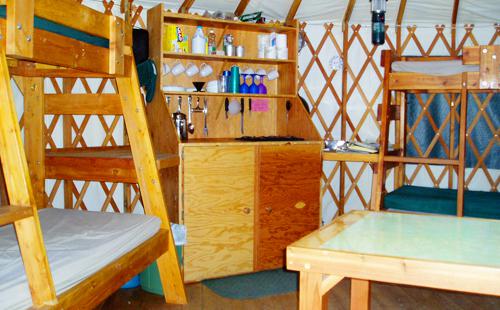
Idaho State Park yurts are circular, Mongolian-style domed tents. Every park yurt is about 20 feet in diameter with a plywood floor, canvas and hardwood sidewalls and a skylight. Most yurts can sleep up to five or six people and is built to withstand high winds, snow loads and summer heat. With lockable wood doors, windows with screens and storm flaps Idaho State Park yurts are a comfortable, peaceful and safe place to be, even in winter! Some parks allow pets in yurts, but please check with the park first.
Idaho City Backcountry Yurts
If you really want to get away from it all, try an Idaho City Backcountry Yurt! From November 15th through April 30th, you will need a Park N’ Ski Pass to park at the Idaho City Backcountry Yurts.
Or reserve by calling (888) 922-6743.
About the Idaho City Backcountry Yurts
The Idaho City yurt system started in the fall of 1996 with construction of the Banner Ridge Yurt. From its inception, the yurt system was intended as a place for outdoor enthusiasts to enjoy the beauty of Idaho’s mountains year-round. You can choose from seven incredible backcountry yurts (Petersen, Banner Ridge, Elkhorn, Skyline, Hennessy, Rocky Ridge, and Stargaze) which are accessible year-round. The yurts are located about 1.5 hours (56-63 miles) north of Boise, ID.
In summer, the yurts are accessed by a few hundred yard hike. In winter, they are accessed by a 1-3 mile ski or snowshoe trek. During spring and fall, users should be prepared for both summer and winter conditions. Condition updates are posted on the Idaho Non-Motorized Trails Program Facebook page.
Each yurt sleeps six people in a comfortable, well-furnished atmosphere with high mountain views, no neighbors, and access to a wide variety of recreational opportunities including hiking, mountain biking, horseback riding, Nordic and Telemark skiing, and snowshoeing. Our backcountry yurts have plenty to offer outdoor enthusiasts at any level, whether beginner or experienced.
To find the summer or winter guide for a yurt, click the tab for yurt you’re visiting. Each yurt tab links to both the summer and winter guides.
Yurt Amenities:
Because of the backcountry nature of the yurts, IDPR cannot guarantee that all the amenities listed below will be available during your stay.
- Sleeps 6 (one futon and two bunk beds)
- Solar powered lights
- Mountain views
- Propane cook stove (bring your own small propane)
- Kitchen basics (pots, pans, large utensils, salt, and pepper)
- Dishes and silverware
- Hot water kettle
- Pour over filter stand
- Plastic cups and wine glasses
- Wood stove (wood provided)
- Dining table and six chairs
- Wooden benches
- Pit toilet
- Cleaning supplies
- Fire extinguisher
- First aid kit
- Carbon monoxide alarm
- Outdoor fire pit (gather your own wood)
- Outdoor picnic table
- Pets welcome
- Summer-use trails (hiking, biking, stock riding, OHV-ing)
- Winter-use trails (skiing, snowboarding, snowshoeing, fat tire biking)
We recommend a high-clearance, all-wheel drive vehicle when traveling to the Idaho City Backcountry yurts.
Click on the image below to view a 360 degree photo of Stargaze Yurt. The interior layouts are similar in all seven yurts.
Reservation Information
Nightly Rates
The Idaho City Backcountry Yurts are transitioning to a dynamic pricing model, meaning prices will vary depending on demand. The maximum fees are listed below.
For Idaho residents: $ Up to 115 per night
For non-residents: $Up to 150 per night
There is a $10 plus tax non-refundable reservation fee charged at the time of booking.
Use fees are per night for a party of up to 6. Additional fees are $12 per person per night for a party greater than 6, with a maximum of 9 allowed.
From November 15th through April 30th, yurt users parking in Whoop Um Up, Gold Fork, Banner Ridge, or Beaver Creek parking lots are required to have a Park N’ Ski pass.
Cancellation Policy
If a cancellation for a Backcountry Yurt occurs 21 or fewer calendar days prior to arrival, customer forfeits the first night or daily usage fee (base rate). If the cancellation occurs more than 21 calendar days prior to arrival, a cancellation charge of $50.00 will be assessed. At no time shall the customer be charged a cancellation fee that exceeds the base rate paid for the facility.
Cancellation exceptions for air quality concerns will be made if the Air Quality Index reading is at 151 or more. Reservations can be cancelled for a full refund if we are contacted within 48 hours of the arrival date. Please use the Idaho Department of Environmental Quality’s Air Quality Map to monitor the conditions at the yurts in real time.
To cancel a reservation Monday – Friday from 8:15AM – 4:45PM MST, please call (208) 514-2444. To cancel a reservation after business hours, please email IDPR Customer Support. When cancelling a reservation, please have your reservation number available.
Questions? Email the program or call 208-514-2418.
Maps and Information
The maps below are geo-referenced. If you open them using a geo-referenced map reader, like Avenza, as long as you download the map while in phone service, you can use your phone’s GPS tracking after leaving service.
- Summer Trail Map
- Winter Trail Map
- Park ‘N Ski Location Map
- Winter Park ‘N Ski Parking Rules
- Trail Descriptions
- Whitebark Pine Information
The Idaho Department of Parks and Recreation Backcountry Yurt Program operates on United States Forest Service Land under agreements with the Boise National Forest.
Current Conditions
For updates on grooming status and trail conditions, visit the Idaho Non-Motorized Trails Program Facebook page.
For air quality, visit the Real-Time Air Monitoring Map by the Idaho Department of Environmental Quality.
For the 7 day forecast in Idaho City, visit weather.gov.
For regional snow conditions, including depth, visit the National Water and Climate Center’s interactive map.
For road conditions, visit the 511 website.
If you plan on recreating in avalanche terrain, visit Avalanche.org
Pet Policy
For the health, safety, and enjoyment of all of our guests and staff the following Pet Policy has been established.
All the yurts are pet-friendly all year around. However, pet allowance is a privilege and is based on your cooperation.
Please be a responsible pet owner and respect the following rules:
- There is a two-pet limit.
- You are liable for the health and welfare of your pet(s) at all times.
- Pets must not be left unattended in the yurt at any time.
- Pets must be clean, house-trained, parasite, and disease free.
- Please pick up after your pet around the yurt and on trails.
- Remember, there will be other guests arriving just after your visit. Please clean up animal hair and sanitize the yurt before you leave.
- You authorize IDPR to assess charges to the credit card on file at registration for any and all damages discovered in or around the yurt prior to or after departure, including but not limited to pet odor and stains, repair or replacement of property, excessive cleaning charges, and/or loss of revenue caused by a pet, including an ADA compliant service dog 28 CFR 36.302 (c) (8).
Idaho City Backcountry Yurts in the News
- Check out The Ultimate Guide from The Mandagie Family and Visit Idaho. The guide includes everything from how to get there, where to park, and what to pack.
- Watch this video about the summer opportunities at the Idaho City Backcountry Yurts.
- Check out this story by Idaho News 6 about winter at the Idaho City Backcountry Yurts.
- Watch Pete Zimowsky of the Idaho Statesman describe his winter experience at an Idaho City Backcountry Yurt.
About Petersen Yurt
The Petersen Yurt is the newest yurt in the Idaho City system, offering year-round access to outstanding trails and wide-open views. Set on a high knob, it features a large deck with clear sightlines to Pilots Peak, Sunset Peak, the Trinity Mountains, Steele Mountain, Wolf Mountain, and the Crooked River Valley. Built to replace the Whispering Pines Yurt lost in the 2016 Pioneer Fire, Petersen brings a fresh backcountry getaway to one of the area’s most scenic ridges.
When the yurt is snow-free, guests can drive a high-clearance vehicle within a couple hundred feet of the front door. During the winter months, guests park in Gold Fork Park N’ Ski parking lot and ski or snowshoe about 1.3 miles to access the yurt.
Check out the summer yurt guide, winter yurt guide, summer trails map, winter trails map, and winter parking guidance.
We recommend a high-clearance, all-wheel drive vehicle when traveling to the Idaho City Backcountry Yurts.
Site Amenities:
- Sleeps 6 (one futon and two bunk beds)
- Solar powered lights
- Mountain views
- Propane cook stove (bring your own propane)
- Kitchen basics (pots, pans, large utensils, salt, and pepper)
- Dishes and silverware
- Hot water kettle
- Pour over filter stand
- Plastic cups and wine glasses
- Wood stove (wood provided)
- Dining table and six chairs
- Wooden benches
- Pit toilet
- Cleaning supplies
- Fire extinguisher
- First aid kit
- Carbon monoxide alarm
- Outdoor fire pit (gather your own wood)
- Outdoor picnic table
- Pets welcome
- Summer-use trails
- Winter-use trails (groomed and ungroomed)
About Banner Ridge Yurt
Banner Ridge backcountry yurt is located just off a high ridge in a protected north‐facing bowl. It offers spectacular views of the South Fork of the Payette River, Bear Valley and Scott Mountain. When the yurt is snow-free, guests can drive with a high-clearance vehicle within a few hundred yards of the front door. During the winter months, guests park in Banner Ridge Park N’ Ski parking lot and ski or snowshoe about two miles to the yurt.
During the warmer months, there are many miles of high elevation primitive roads and trails available for hiking, mountain biking and stock users. Nearby, off-highway vehicle users can find trails to enjoy. One backcountry road near the yurt descends 3,000 feet in 12 miles to Kirkham Hot Springs, a primitive soaking pool along the South Fork of the Payette River. During the winter, the yurt is a telemarker, snowshoer, Nordic skier and snowboarder’s haven with its long, open slopes, thousands of feet of untracked powder. Banner Ridge Yurt also provides access to more than 20 miles of groomed and 20 miles of ungroomed ski and snowshoe trails just outside the front door.
Check out the summer yurt guide, winter yurt guide, summer trails map, winter trails map, and winter parking guidance.
We recommend a high-clearance, all-wheel drive vehicle when traveling to the Idaho City Backcountry Yurts.
Site Amenities:
Because of the backcountry nature of the yurts, IDPR cannot guarantee that all the amenities listed below will be available during your stay.
- Sleeps 6 (one futon and two bunk beds)
- Solar powered lights
- Mountain views
- Propane cook stove (bring your own propane)
- Kitchen basics (pots, pans, large utensils, salt, and pepper)
- Dishes and silverware
- Hot water kettle
- Pour over filter stand
- Plastic cups and wine glasses
- Wood stove (wood provided)
- Dining table and six chairs
- Wooden benches
- Pit toilet
- Cleaning supplies
- Fire extinguisher
- First aid kit
- Carbon monoxide alarm
- Outdoor fire pit (gather your own wood)
- Outdoor picnic table
- Pets welcome
- Summer-use trails
- Winter-use trails (groomed and ungroomed)
About Elkhorn Yurt
The Elkhorn Yurt is conveniently located for both winter and summer trail users. This yurt is the most remote of all the Idaho City yurts. When the yurt is snow-free, guests can drive within a few hundred yards of the front door. During the winter months, guests park in Banner Ridge Park N’ Ski parking lot and ski or snowshoe about three miles to access the yurt.
Guests have direct access to over 27 miles of groomed and 20 miles of ungroomed ski trails. The 270° view to the east, south and west is spectacular, especially in the evening. From the yurt you can see Jackson Peak, Wolf Mountain, Steele Mountain, the Trinity range, Sunset Peak, and Pilot Peak. The open, rolling terrain below the yurt provides off‐trail skiers a chance to polish their skills. The nearby ungroomed Cougar trail provides access to a prime telemark skiing area. During the summer months, over 50 miles of decommissioned roads and single‐track trails can be accessed from this yurt, which is located about halfway around the Elkhorn Loop trail. Nearby, off-highway vehicle users can find trails to enjoy.
Check out the summer yurt guide, winter yurt guide, summer trails map, winter trails map, and winter parking guidance.
We recommend a high-clearance, all-wheel drive vehicle when traveling to the Idaho City Backcountry Yurts.
Site Amenities:
Because of the backcountry nature of the yurts, IDPR cannot guarantee that all the amenities listed below will be available during your stay.
- Sleeps 6 (one futon and two bunk beds)
- Solar powered lights
- Mountain views
- Propane cook stove (bring your own propane)
- Kitchen basics (pots, pans, large utensils, salt, and pepper)
- Dishes and silverware
- Hot water kettle
- Pour over filter stand
- Plastic cups and wine glasses
- Wood stove (wood provided)
- Dining table and six chairs
- Wooden benches
- Pit toilet
- Cleaning supplies
- Fire extinguisher
- First aid kit
- Carbon monoxide alarm
- Outdoor fire pit (gather your own wood)
- Outdoor picnic table
- Pets welcome
- Summer-use trails
- Winter-use trails (groomed and ungroomed)
Be Advised: From September 15th through June 15th, the gate to access Skyline Yurt is closed at Highway 21. To access Skyline during this period, whether there is snow or not, yurt guests must hike 2.3 miles from Goldfork parking lot to the yurt.
About Skyline Yurt
The Skyline Yurt is located on a high sunny knob, which provides a 200-degree view to the east, south and west. When the yurt is snow-free, guests can drive with a high clearance vehicle within a few hundred feet of the front door. During the winter months, guests park in Gold Fork Park N’ Ski parking lot and ski or snowshoe about two and a half miles to access the yurt.
The view from Skyline Yurt is one of the best in the Boise National Forest. From the yurt deck you can see Wolf Mountain, Steele Mountain, Sunset Peak, and Pilot Peak. Nearby, off-highway vehicle users can find trails to enjoy. Numerous large spruce trees nearby provide a nice, shaded area for picnics. In the fall, flaming red, yellow, and orange aspens frame the mountain peaks to the east. A protected tent area is available for extra people.
During the winter months, Skyline Yurt is conveniently situated off the groomed Skyline trail, a popular loop used by Nordic skiers and snowshoers. The yurt provides access to over 20 miles of groomed and 20 miles of ungroomed winter trails. The yurt is The open, rolling terrain below the yurt provides beginner Telemarkers a chance to polish their skills.
Check out the summer yurt guide, winter yurt guide, summer trails map, winter trails map, and winter parking guidance.
We recommend a high-clearance, all-wheel drive vehicle when traveling to the Idaho City Backcountry Yurts.
Site Amenities:
- Sleeps 6 (one futon and two bunk beds)
- Solar powered lights
- Mountain views
- Propane cook stove (bring your own propane)
- Kitchen basics (pots, pans, large utensils, salt, and pepper)
- Dishes and silverware
- Hot water kettle
- Pour over filter stand
- Plastic cups and wine glasses
- Wood stove (wood provided)
- Dining table and six chairs
- Wooden benches
- Pit toilet
- Cleaning supplies
- Fire extinguisher
- First aid kit
- Carbon monoxide alarm
- Outdoor fire pit (gather your own wood)
- Outdoor picnic table
- Pets welcome
- Summer-use trails
- Winter-use trails (groomed and ungroomed)

About Hennessy Yurt
Hennessy Yurt is the newest yurt in the Idaho City system. It is located on a high, unburned knob with great views. When the yurt is snow-free, guests can drive a high-clearance vehicle within a couple hundred feet of the front door. During the winter months, guests park in Gold Fork Park N’ Ski parking lot and ski or snowshoe about two miles to access the yurt.
The Hennessy Yurt replaced the Whispering Pines Yurt that was burned during the 2016 Pioneer Fire. The elevated yurt deck is a great place to enjoy the views or experience a mountain thunderstorm. From the large yurt deck you can see Pilots Peak, Sunset Peak, Trinity Mountains, Steele Mountain, Wolf Mountain, and the Crooked River Valley. If you want a quiet getaway in the forest, this is your place. Check out this article from Pacific Yurts to learn more about the yurt’s namesake.
Check out the summer yurt guide, winter yurt guide, summer trails map, winter trails map, and winter parking guidance.
We recommend a high-clearance, all-wheel drive vehicle when traveling to the Idaho City Backcountry Yurts.
Site Amenities:
- Sleeps 6 (one futon and two bunk beds)
- Solar powered lights
- Mountain views
- Propane cook stove (bring your own propane)
- Kitchen basics (pots, pans, large utensils, salt, and pepper)
- Dishes and silverware
- Hot water kettle
- Pour over filter stand
- Plastic cups and wine glasses
- Wood stove (wood provided)
- Dining table and six chairs
- Wooden benches
- Pit toilet
- Cleaning supplies
- Fire extinguisher
- First aid kit
- Carbon monoxide alarm
- Outdoor fire pit (gather your own wood)
- Outdoor picnic table
- Pets welcome
- Summer-use trails
- Winter-use trails (groomed and ungroomed)
About Rocky Ridge Yurt
Rocky Ridge Yurt is perched on the end of a finger ridge and provides a spectacular 180-degree view to the east, south, and west. When the yurt is snow-free, guests can drive with a high-clearance vehicle within a few hundred yards of the front door. During the winter months, Rocky Ridge Yurt is about a two mile ski or snowshoe from Whoop-Um-Up Park N’ Ski parking lot. The trails to access Rocky Ridge Yurt are not groomed.
Rocky Ridge yurt is on the southern end of the Idaho City Trail system and is ideally located for fishing in the Crooked River. It is about ¾ of a mile from the Crooked River by way of the Lamar Creek trail.
Check out the summer yurt guide, winter yurt guide, summer trails map, winter trails map, and winter parking guidance.
Site Amenities:
Because of the backcountry nature of the yurts, IDPR cannot guarantee that all the amenities listed below will be available during your stay.
- Sleeps 6 (one futon and two bunk beds)
- Solar powered lights
- Mountain views
- Propane cook stove (bring your own propane)
- Kitchen basics (pots, pans, large utensils, salt, and pepper)
- Dishes and silverware
- Hot water kettle
- Pour over filter stand
- Plastic cups and wine glasses
- Wood stove (wood provided)
- Dining table and six chairs
- Wooden benches
- Pit toilet
- Cleaning supplies
- Fire extinguisher
- First aid kit
- Carbon monoxide alarm
- Outdoor fire pit (gather your own wood)
- Outdoor picnic table
- Pets welcome
- Summer-use trails
- Winter-use trails (ungroomed)
About Stargaze Yurt
You’ll understand how Stargaze got its name after you arrive. The spectacular 270-degree view from the yurt offers open vistas to Scott Mountain, Jackson Peak, Wolf Mountain, Steele Mountain, Pilots Peak and the Sawtooth Mountains. On clear evenings, you will experience unparalleled views of the night sky. When the yurt is snow-free, guests can drive with a high-clearance vehicle within a few hundred yards of of the front door. During the winter months, guests park in Beaver Creek Summer Park N’ Ski parking lot and ski or snowshoe about a mile and a half to access the yurt.
In addition to the spectacular views, the elevation of Stargaze (6,569 feet) guarantees an assortment of wildflowers during the summer months and a blaze of color in the fall. Once at the yurt, a short half-mile hike, ski, or snowshoe on a trail leads to the top of Stargaze Point. On this point you will have a 360-degree view of the Boise National Forest. During the winter months, many north and west facing slopes are perfect for backcountry skiing or snowboarding.
Check out the summer yurt guide, winter yurt guide, summer trails map, winter trails map, and winter parking guidance.
We recommend a high-clearance, all-wheel drive vehicle when traveling to the Idaho City Backcountry Yurts.
Site Amenities:
Because of the backcountry nature of the yurts, IDPR cannot guarantee that all the amenities listed below will be available during your stay.
- Sleeps 6 (one futon and two bunk beds)
- Solar powered lights
- Mountain views
- Propane cook stove (bring your own propane)
- Kitchen basics (pots, pans, large utensils, salt, and pepper)
- Dishes and silverware
- Hot water kettle
- Pour over filter stand
- Plastic cups and wine glasses
- Wood stove (wood provided)
- Dining table and six chairs
- Wooden benches
- Pit toilet
- Cleaning supplies
- Fire extinguisher
- First aid kit
- Carbon monoxide alarm
- Outdoor fire pit (gather your own wood)
- Outdoor picnic table
- Pets welcome
- Summer-use trails
- Winter-use trails (ungroomed)


For up-to-date conditions at the Idaho City Backcountry Yurts, check out the Idaho Non-Motorized Trails Program Facebook Page.
Idaho City Backcountry Yurt FAQs
Access to the Idaho City Yurts varies by season:
-
Winter (snowy months): Yurts are accessed by skiing or snowshoeing. Roads are not plowed to the yurts, and motorized access is not available.
-
Summer: You can drive to within a few hundred yards of the yurt, making access relatively easy.
-
Shoulder seasons (spring and fall): Conditions can change quickly. Be prepared for a mix of snow, mud, and variable road conditions, and plan for flexible access depending on the weather.
No matter the season, we recommend checking current conditions and packing accordingly.
Yes. All Idaho City yurts are equipped with nearby vault (pit) toilets. While they are rustic and do not have running water, they are well maintained — and many come with surprisingly great views, making them some of the most scenic pit toilets you’ll ever use!
Water availability depends on the season:
-
Winter: There is no water. Guests should plan to melt snow for water.
-
Summer: Yurts are supplied with non-potable water tanks that can be used for cleaning and washing only. Drinking water must be brought with you. Some yurts have nearby streams or springs that guests may choose to filter or treat for drinking water. When temperatures start to freeze, water tanks are drained to prevent damage.
Guests should plan ahead for their water needs based on current conditions and the season of their stay.
Each Idaho City Yurt can comfortably sleep up to six people. Yurts are furnished with two bunk beds and one futon. Guests should bring their own sleeping bags or bedding/linens.
No. The Idaho City Yurts do not have standard electricity. However, each yurt is equipped with solar panels that power basic interior lights. Guests should still plan to bring headlamps or lanterns and extra batteries for additional lighting needs.
Cell service is limited to unavailable, depending on your carrier and location. Guests should plan accordingly and not rely on cell service during their stay.
Check-in is at 3PM and check-out is at 11AM. Check-in and check-out procedures can be found on the wall of the yurt. The yurts are not serviced between every guest, so please leave it cleaner than you found it!
Yes! Pets are allowed at all of the yurts. But please be respectful to future guests by picking up after your pet.
Yes! Each yurt includes a propane cook stove, plus dishes, pots, pans, utensils, and silverware. Bring your own 1-lb. propane bottles for the cook stove. Each yurt even has a cast iron griddle and a wok!


